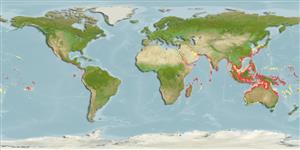分類 / Names
俗名 | 同種異名 | Catalog of Fishes(屬, 種) | ITIS | CoL | WoRMS | Cloffa
Teleostei >
Tetraodontiformes (Puffers and filefishes)
魨形目 (Puffers and filefishes) >
Tetraodontidae (Puffers)
四齒魨科 (Puffers) > Tetraodontinae
Etymology: Takifugu: A Japanese word with several meanings; taki = waterfall + fugu = fish; it could be also understood as taki = to be cooked in liquid + fugu = a venomous fish.
More on author: Bloch.
Environment: milieu / climate zone / depth range / distribution range
生態學
海洋; 半鹹淡水 居於水底的. 熱帶
Indo-West Pacific: South Africa to Indonesia, north to Japan, south to Australia.
印度-西太平洋: 南非,馬達加斯加與留尼旺島 (參考文獻 33390 到印尼澳洲。
大小 / 重量 / 年齡
Maturity: Lm ? range ? - ? cm
Max length : 40.0 cm TL 雄魚/尚未辨別雌雄; (Ref. 4919)
背棘 (總數) : 0; 背的軟條 (總數) : 12 - 14; 臀棘: 0; 臀鰭軟條: 10 - 12. Body covered with prickles (Ref. 559). Brownish above with pale spots, yellowish white below; narrow dark bars on sides (Ref. 4919).
身體覆蓋著刺。 (參考文獻 559) 上方褐色的有灰白的斑點, 下面黃白色的; 在側邊上的狹窄的深色橫帶.(參考文獻 4919)
Lives in shallow coastal waters, but enters brackish waters (Ref. 4833).
生活在沿岸淺水區, 但是進入半鹹淡水域.(參考文獻 4833)
Life cycle and mating behavior
成熟度 | 繁殖 | 產卵場 | 卵 | 孕卵數 | 仔魚
印度-西太平洋: 南非,馬達加斯加與留尼旺島 (參考文獻 33390 到印尼澳洲。
Masuda, H., K. Amaoka, C. Araga, T. Uyeno and T. Yoshino, 1984. The fishes of the Japanese Archipelago. Vol. 1. Tokai University Press, Tokyo, Japan. 437 p. (text). (Ref. 559)
IUCN 瀕危狀態 (Ref. 130435: Version 2024-1)
無危 (LC) ; Date assessed: 10 June 2011
人類使用
漁業: 潛在的興趣
工具
特別的報告
下載 XML
網路資源
Estimates based on models
Preferred temperature (Ref.
123201): 24.1 - 29.1, mean 28.2 °C (based on 1410 cells).
Phylogenetic diversity index (Ref.
82804): PD
50 = 0.5000 [Uniqueness, from 0.5 = low to 2.0 = high].
Bayesian length-weight: a=0.01995 (0.01156 - 0.03445), b=2.90 (2.76 - 3.04), in cm total length, based on LWR estimates for this species & Genus-body shape (Ref.
93245).
營養階層 (Ref.
69278): 3.2 ±0.44 se; based on food items.
回復力 (Ref.
120179): 中等的, 族群倍增時間最少 1.4 - 4.4年 (Preliminary K or Fecundity.).
Fishing Vulnerability (Ref.
59153): Low to moderate vulnerability (30 of 100).
